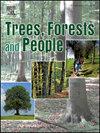Varietal-specific growth performance and ecological restoration Potential of Olea europaea L. in Abandoned Mine Slags
IF 2.7
Q1 FORESTRY
引用次数: 0
Abstract
Mine ecological restoration is an important means of improving the ecological environment of abandoned mining areas, and the selection and configuration of plant species play a critical role in the restoration outcomes. This study aims to investigate the effects of different types of mining slag on the growth performance and survival rate of olive cultivars, providing a scientific basis for mine ecological restoration. The experimental results indicate significant differences in the physicochemical properties of the mining soils: clay slag had a near-neutral pH (6.856) and an organic matter content of 13.848 g/kg. In comparison, the sandy soil was acidic (pH 5.678) with a slightly higher organic matter content (16.481 g/kg). However, the heavy metal content (e.g., mercury, arsenic, chromium, cadmium, and lead) in sandy soil was generally higher than in clay, which may negatively affect plant growth and ecological restoration. The growth performance of different olive cultivars varied markedly, with ‘Arbequina’ showing the best performance in terms of seedling height (108.67 cm), total growth (58.67 cm), and crown width (92 cm east-west, 85 cm north-south), making it suitable as a primary restoration species for high-erosion-risk areas. ‘Arbosana’ exhibited moderate performance but had a higher survival rate in clay slag (83.75 %), making it suitable for clay-rich areas, while ‘Koroneiki’ showed weaker growth performance. Additionally, the slag type significantly influenced the survival rate of the cultivars: ‘Arbequina’ had the highest survival rate in gravelly slag (92.86 %), ‘Arbosana’ performed better in clay slag (83.75 %), and ‘Koroneiki’ had similar survival rates in both slag types (82.11 % in gravelly slag and 80.95 % in clay slag). Heavy metal accumulation in leaves varied among cultivars, with ‘Arbosana’ and ‘Koroneiki’ accumulating more lead, mercury, arsenic, and cadmium in clay slag, whereas ‘Arbequina’ showed a higher accumulation of all heavy metals in gravelly slag. In conclusion, ‘Arbequina’ and ‘Arbosana’ demonstrated excellent performance in mine restoration and are suitable as primary restoration species, while ‘Koroneiki’ can serve as a supplementary cultivar. By optimizing zonal planting strategies and enhancing management measures, the effectiveness of mine ecological restoration can be significantly improved, offering a feasible solution for vegetation recovery in similar mining areas.
废矿渣中油橄榄的品种特异性生长性能及生态恢复潜力
矿山生态恢复是改善废弃矿区生态环境的重要手段,植物物种的选择和配置对恢复效果起着至关重要的作用。本研究旨在探讨不同类型矿渣对橄榄品种生长性能和成活率的影响,为矿山生态修复提供科学依据。试验结果表明,矿用土的理化性质存在显著差异:粘土渣的pH值接近中性(6.856),有机质含量为13.848 g/kg。沙质土壤呈酸性,pH为5.678,有机质含量略高,为16.481 g/kg。然而,沙质土壤中的重金属(如汞、砷、铬、镉和铅)含量普遍高于粘土,这可能对植物生长和生态恢复产生不利影响。不同橄榄品种的生长表现差异较大,其中“阿贝昆纳”在幼苗高(108.67 cm)、总生长量(58.67 cm)和树冠宽(东西92 cm、南北85 cm)方面表现最佳,适合作为高侵蚀风险区的初级恢复树种。‘Arbosana’的生长性能一般,但在粘土渣中的成活率较高(83.75%),适合于粘土丰富的地区,而‘Koroneiki’的生长性能较弱。此外,矿渣类型对不同矿渣的成活率也有显著影响,“阿贝奎纳”在砂渣中的成活率最高(92.86%),“阿博萨纳”在粘土渣中的成活率较好(83.75%),“科罗涅基”在两种矿渣中的成活率相近(砂渣中的82.11%和粘土渣中的80.95%)。不同品种叶片中重金属的积累量不同,‘Arbosana’和‘Koroneiki’在粘土渣中积累的铅、汞、砷和镉更多,而‘Arbequina’在砂砾渣中积累的所有重金属都更高。综上所述,‘Arbequina’和‘Arbosana’在矿山恢复中表现良好,适合作为初级恢复品种,而‘Koroneiki’可以作为补充恢复品种。通过优化分区种植策略和加强管理措施,可以显著提高矿区生态恢复的有效性,为类似矿区植被恢复提供了可行的解决方案。
本文章由计算机程序翻译,如有差异,请以英文原文为准。
求助全文
约1分钟内获得全文
求助全文
来源期刊

Trees, Forests and People
Economics, Econometrics and Finance-Economics, Econometrics and Finance (miscellaneous)
CiteScore
4.30
自引率
7.40%
发文量
172
审稿时长
56 days
 求助内容:
求助内容: 应助结果提醒方式:
应助结果提醒方式:


